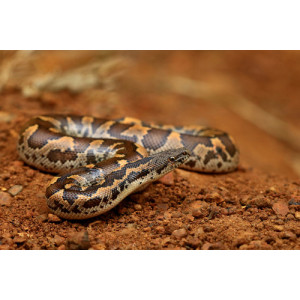Burmese Python Did you see this animal?
Scientific Name : Python bivittatus
Family : Pythonidae
Order : Squamata
Class : Reptilia
Phylum : Chordata
Other Name : Rock Python,Indian Rock Python
Habitat : Humid forests,Estuarine,Mangrove forests,Rainforests,Grasslands,Marshes,Streams,Rivers and Wetlands
Description : The Burmese python is one of the largest snake species in the world, with adults reaching lengths of up to 23 feet and weights of over 200 pounds.
They have a distinctive pattern of dark brown or black blotches on a lighter background, which can range from yellow to brown.
Burmese pythons are found in a variety of habitats, including forests, grasslands, and swamps.
They are carnivores and feed on a wide range of prey, including rodents, birds, and other reptiles. Larger individuals have been known to prey on deer and even alligators.
Burmese pythons are generally solitary creatures and are active mainly at night. They are excellent swimmers and climbers, and are known to be good ambush predators.
Burmese pythons are oviparous, which means they lay eggs. Females can lay up to 100 eggs at a time, which they then coil around to protect and incubate until they hatch.
The Burmese python is not currently listed as endangered, but it is considered an invasive species in Florida and other parts of the United States, where it has been introduced as a result of the pet trade.
In their native range, Burmese pythons play an important ecological role as top predators. In the pet trade, they are popular but require specialized care and handling due to their large size and strength.
Burmese pythons have been known to attack humans, particularly when they feel threatened or cornered. However, such incidents are relatively rare, and most encounters with Burmese pythons are peaceful.
In addition to being hunted for their skin and meat, Burmese pythons are a threat to native wildlife in areas where they have been introduced. They have been known to prey on a wide range of species, including birds, mammals, and reptiles, and are considered a major threat to the ecological balance of these ecosystems.
They have a distinctive pattern of dark brown or black blotches on a lighter background, which can range from yellow to brown.
Burmese pythons are found in a variety of habitats, including forests, grasslands, and swamps.
They are carnivores and feed on a wide range of prey, including rodents, birds, and other reptiles. Larger individuals have been known to prey on deer and even alligators.
Burmese pythons are generally solitary creatures and are active mainly at night. They are excellent swimmers and climbers, and are known to be good ambush predators.
Burmese pythons are oviparous, which means they lay eggs. Females can lay up to 100 eggs at a time, which they then coil around to protect and incubate until they hatch.
The Burmese python is not currently listed as endangered, but it is considered an invasive species in Florida and other parts of the United States, where it has been introduced as a result of the pet trade.
In their native range, Burmese pythons play an important ecological role as top predators. In the pet trade, they are popular but require specialized care and handling due to their large size and strength.
Burmese pythons have been known to attack humans, particularly when they feel threatened or cornered. However, such incidents are relatively rare, and most encounters with Burmese pythons are peaceful.
In addition to being hunted for their skin and meat, Burmese pythons are a threat to native wildlife in areas where they have been introduced. They have been known to prey on a wide range of species, including birds, mammals, and reptiles, and are considered a major threat to the ecological balance of these ecosystems.
Distribution in Bangladesh
References:
description written by: Razia Sultana Setu,Department of Zoology,University of Dhaka ; information source:Wikipedia, IUCN Red List Bangladesh Volume-4 2015; photo credit:曾威 (Wei Tseng)(www.inaturalist.org/people/曾威 (Wei Tseng)), photo copyright: iNaturalist. more information please contact with us.
description written by: Razia Sultana Setu,Department of Zoology,University of Dhaka ; information source:Wikipedia, IUCN Red List Bangladesh Volume-4 2015; photo credit:曾威 (Wei Tseng)(www.inaturalist.org/people/曾威 (Wei Tseng)), photo copyright: iNaturalist. more information please contact with us.































